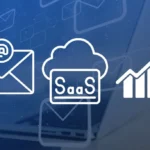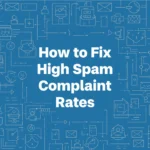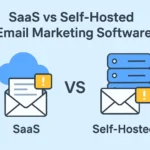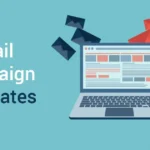Bulk emails can bounce because of a combination of issues with your list, reputation as a sender, and content of the message. Soft bounces can be caused by temporary problems, such as invalid email addresses. Hard bounces occur when delivery is permanently failed.
High bounce rates can harm your sender’s reputation by causing legitimate emails be marked as spam and then rejected by email providers. This blog includes the reasons why bulk email bounces and solutions to stop your emails from bouncing.
Reasons Bulk Emails Bounce
Bulk emails usually bounce due to any problem with your email list, the reputation of your mail sender and the arrangement of your message. Failure to deliver may also be caused by invalid addresses, low authentication or spammy content. Knowing these issues will enable you to optimize your bulk email marketing campaign as well as ensure high deliverability.
List and Recipient Issues
- Hard bounces will be sent to emails that contain invalid or nonexistent email addresses. This includes addresses that are incorrectly spelled, false, or not active.
- Lists purchased or scraped: These lists are usually low quality and contain invalid addresses as well as “spam traps”, which is the term used by Internet Service Providers to catch spammers. Sending your email to these lists can severely damage your reputation.
- Inbox full: An inbox can be full and cause a soft bounce. It can be an indication of an inactive account.
- Hard bounces are produced by accounts that have either been disabled or deleted.
- Disposable email: Some users use temporary or burner emails that will self-destruct in a few days and bounce.
Sender Reputation and Authentication Issues
- Sender reputation low: Your sender’s reputation is the score ISPs use when evaluating your trustworthiness. Your emails can be blocked if you have a low score. This is often due to high bounce rates and spam complaints.
- IP or domain blacklisted: Your domain can be blocked if you are associated with spamming. It can occur if another sender with the same IP address has a bad reputation.
- Spam filters are alerted when you send bulk emails from free email domains like @gmail.com and @yahoo.com. This is because spammers use these addresses.
- Poor email authentication or non-existent: Major email service providers such as Google and Yahoo demand that senders authenticate their emails using SPF, DKIM and DMARC protocols. Failure to authenticate indicates that you are a fake sender.
- New IP address: A new IP address is not well-known and can be suspicious if you send a lot of email right away.
Content and Technical Issues
- Spammy content. Filters will be triggered by words and phrases associated with spam. For example, limited-time offers written in all capital letters or exclamation marks that are excessive.
- Images or large attachments: Make sure that the emails that contain images or attachments of unusual size or a high image to text ratio may trigger spam filters or they could exceed the recipient’s server limits and cause a soft bounce.
- Misleading headers: The subject lines and From deceptive names can violate anti-spam laws and can result in email rejection.
How to Stop Your Bulk Emails from Bouncing?
One of the first ways of reducing bounces is by being strategic in relation to sending and managing your bulk email marketing campaigns. Get down to business with building real subscriber relationships rather than using the shortcuts that damage your credibility. Regular list care, reputation management and intelligent content optimization can be used to ensure that your emails are safely delivered into the inbox and not spam.
Keep a Healthy Email List
- Use double opt-in: This option will require that new subscribers verify their email address by confirming their subscription. This will make the address valid and the user will actually be interested in getting your emails.
- Clean your list regularly: Take out invalid, unresponsive and non-responsive email addresses. This can be automated with the help of email verification tools.
- Do not purchase email lists: Mail lists should not be purchased or scraped; they are usually full of spam traps and bad email addresses that will destroy your reputation as a mailer.
- Segment your audience: Deliver relevant content by sending targeted content to a segmented list based on interest or level of engagement. Individual emails will have fewer chances of being spam.
Improve Your Sender Reputation
- Authenticate domain: Create SPF, DKIM and DMARC records in order to show ISPs your emails are genuine.
- Warm up new IPs: When using a brand new IP, increase your email volume gradually over several weeks. This will build your reputation, and prevent you from being flagged as spam.
- Use a professional service for email: Instead of using a Gmail or Outlook personal account, use a reputable Email Service Provider. ESPs handle your IP reputation as well as throttling.
- Check the score as a sender: To track your reputation, as well as troubleshoot, you can use tools such as Google Postmaster or Sender Score.
Optimize Your Email Content
- Eschew triggers in spam: Speak plainly and professionally and avoid capital letters, undue use of punctuation and spam words. Write subject lines that will be representative of the content.
- Keep it short: Make the size of your email as small as possible with image compressions and the use of links to big files rather than attachments. Maintain the balance between text and images.
- Have a clear unsubscribe link: Have an unsubscribe link which is prominent and easily accessible. This will be mandated by law and will motivate the users to unsubscribe instead of marking your email as spam.
Manage Bounces When They Occur
- Instantly delete hard bounces: When an email address hard bounces do not keep it on your list. Sending messages to the wrong addresses repeatedly will be damaging to your reputation.
- Monitor soft bounces: Track accounts that soft bounce consistently. Consider removing the addresses from your list if you find that temporary problems persist across multiple campaigns.
- Maintain consistent volume: ISPs prefer consistent, predictable sending patterns. Sudden spikes in volume can trigger filters.
Conlusion
The bounced email is not just a delivery problem; it is a major indication that something is wrong with your bulk email marketing strategy. It can be unverified contacts, unreliable sender authentication, or spam material, but no matter the cause of the bounce, it gives you insight of how to better.
Become a bouncer/ improve deliverability by having a verified and segmented email list, authenticating your domain, and keeping a watch on your sender reputation with the help of a self-hosted email marketing application like Relayzo. You can significantly cut bounce rates and improve deliverability.
Keep in mind that effective bulk email marketing is not about the quantity that is to be mailed but about the quantity that ought to be sent that is smarter. Always have clean lists, relevant content and a good reputation by the sender to ensure that your emails go to the place they belong, the inbox.




















